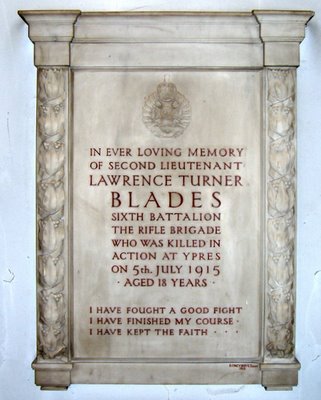 Who was L.T. Blades?
Who was L.T. Blades?A young man who grew up in Reigate, Surrey and went to the Charterhouse school near Godalming. ( a contemporary of Robert Graves )
He had just finished school, in the summer of 1914, with his whole life in front of him, when World War 1 started and he joined the Rifle Brigade. In less than a year he was “killed in action” at Ypres and became part of the tragic waste of an entire generation dying in the mud of Flanders. This memorial is a stark reminder to us all of the human cost of War.
Why is this memorial here in St Nicholas, Sutton?
Lawrence Turner Blades was the only son of the Rector’s daughter ( Ethel Mary Turner ), who had married into the Blades family in 1893 – a well known local St. Nicholas church family living in Suffolk House, less than a minutes walk away from the church, on the Cheam road. ( Suffolk House is now Sutton High School’s music department )
There is a brass cross in the church in memory of Beatrice Blades, his aunty and also a plaque in memory of Ellen E Turner , his grandmother.
His grandfather, Canon William Herbert Turner was highly regarded locally , not just as a respected clergyman but as a friend of the poor and needy; being involved in local schools (Chairman of the School Managers for many years), local hospitals, (served as president of the cottage hospital) and charity throughout the county serving as the Grand master of the province of Surrey for the freemasons.
Canon Turner was the Rector at St Nicholas from 1886 until his death in 1922, after 10 years as a curate building up the first congregation of Christchurch ! He was 68 by 1915 and his health was beginning to fail – the loss of his grandson, right at the start of the war, must have been a cruel blow as this extract from his Obituary hints:
“ One thing only called forth strong condemnation from him and that was the action of Germany in thrusting a war upon the world. In eloquent terms he proclaimed the duty of Britain to fight for the right, but the anxious years of the war weighed upon his spirits, and his heart was heavy with sorrow for the many among his parishioners who suffered loss in the war. That anxiety and sorrow marked the beginning of the decline in his health. “
After his death a memorial walk and seat was created in Manor Park to his memory – today only a wall survives.
Click Here to continue.